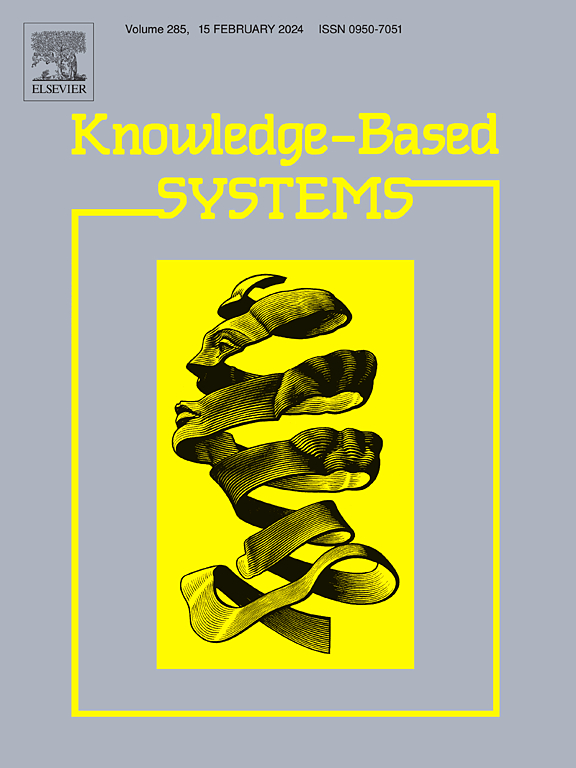Registration-fusion binocular diffusion model: Exploring continuous fusion of unregistered hyperspectral and multispectral images
IF 7.6
1区 计算机科学
Q1 COMPUTER SCIENCE, ARTIFICIAL INTELLIGENCE
引用次数: 0
Abstract
The fusion of hyperspectral image (HSI) and multispectral image (MSI) constitutes an effective approach to obtain high spatial resolution HSI (HR-HSI). However, in practice, multi-source images obtained under different imaging conditions are difficult to be perfectly registered. The vast majority of existing fusion methods crudely assume that HSI and MSI are registered, which is challenging to generalize to practical applications. To this end, we propose a unified registration-fusion binocular diffusion model (RF-BDiff) to achieve continuous fusion of unregistered HSI and MSI. RF-BDiff alternately optimizes image registration and fusion tasks to gradually recover HR-HSI by repeated refinement over multi time steps. The refinement operation at each time step is performed by the specially designed implicit neural registration module (INRM) and invertible spatial–spectral fusion module (IS2FM). INRM parameterizes the mapping between spatial coordinates of MSI and spectral values of reconstructed image and HSI as continuous implicit functions to provide the registered spatial coordinates for subsequent refinement. IS2FM designs an invertible bijective transformation for modeling fusion problem of registered images to reduce the information loss in fusion process and enriches the spatial–spectral information of reconstructed image. INRM and IS2FM are executed alternately to continuous fuse unregistered HSI and MSI. Such a design is conducive to the generalization of RF-BDiff in real applications, and we especially provide a real dataset to verify its effectiveness in real scenarios. Systematic experiments on simulated and real datasets demonstrate the state-of-the-art performance of RF-BDiff.
配准融合双目扩散模型:探索未配准高光谱和多光谱图像的连续融合
高光谱图像与多光谱图像的融合是获得高空间分辨率高光谱图像的有效途径。但在实际应用中,在不同成像条件下获得的多源图像很难进行完美配准。现有的绝大多数融合方法都是粗糙地假设HSI和MSI是注册的,很难推广到实际应用中。为此,我们提出了一种统一配准融合双目扩散模型(RF-BDiff)来实现未配准HSI和MSI的连续融合。RF-BDiff交替优化图像配准和融合任务,通过多时间步重复细化,逐步恢复HR-HSI。每个时间步的细化操作由特别设计的隐式神经配准模块(INRM)和可逆空间-光谱融合模块(IS2FM)完成。INRM将MSI空间坐标与重构图像和HSI光谱值之间的映射关系参数化为连续隐式函数,为后续的细化提供配准的空间坐标。IS2FM设计了一种可逆双客观变换来建模配准图像的融合问题,以减少融合过程中的信息损失,丰富重构图像的空间光谱信息。INRM和IS2FM交替执行,以持续融合未注册的恒生指数和摩根士丹利指数。这样的设计有利于RF-BDiff在实际应用中的推广,我们特别提供了一个真实的数据集来验证其在实际场景中的有效性。在模拟和真实数据集上的系统实验证明了RF-BDiff的最先进性能。
本文章由计算机程序翻译,如有差异,请以英文原文为准。
求助全文
约1分钟内获得全文
求助全文
来源期刊

Knowledge-Based Systems
工程技术-计算机:人工智能
CiteScore
14.80
自引率
12.50%
发文量
1245
审稿时长
7.8 months
期刊介绍:
Knowledge-Based Systems, an international and interdisciplinary journal in artificial intelligence, publishes original, innovative, and creative research results in the field. It focuses on knowledge-based and other artificial intelligence techniques-based systems. The journal aims to support human prediction and decision-making through data science and computation techniques, provide a balanced coverage of theory and practical study, and encourage the development and implementation of knowledge-based intelligence models, methods, systems, and software tools. Applications in business, government, education, engineering, and healthcare are emphasized.
 求助内容:
求助内容: 应助结果提醒方式:
应助结果提醒方式:


